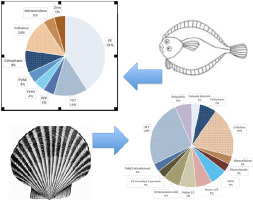当前位置:
X-MOL 学术
›
Environ. Pollut.
›
论文详情
Our official English website, www.x-mol.net, welcomes your feedback! (Note: you will need to create a separate account there.)
A preliminary analysis of microplastics in edible versus non-edible tissues from seafood samples.
Environmental Pollution ( IF 8.9 ) Pub Date : 2020-03-27 , DOI: 10.1016/j.envpol.2020.114452 Fleurine Akoueson 1 , Lisa M Sheldon 2 , Evangelos Danopoulos 3 , Steve Morris 4 , Jessica Hotten 2 , Emma Chapman 2 , Jiana Li 5 , Jeanette M Rotchell 2
Environmental Pollution ( IF 8.9 ) Pub Date : 2020-03-27 , DOI: 10.1016/j.envpol.2020.114452 Fleurine Akoueson 1 , Lisa M Sheldon 2 , Evangelos Danopoulos 3 , Steve Morris 4 , Jessica Hotten 2 , Emma Chapman 2 , Jiana Li 5 , Jeanette M Rotchell 2
Affiliation

|
Plastics have been widely reported to be present in the environment yet there are still many questions regarding the extent of this and the impacts these may have on both the environment and human health. The purpose of this investigation is to determine levels of micro and mesoplastic (MP), in the 1-5000 μm range, in commercially important species of finfish and shellfish. Additionally, to determine and compare the relative MP levels in edible versus non-edible tissues, and consider the wider implications in terms of human health concerns with a preliminary risk identification approach. For several fish species, samples taken from typically non-edible (gills, digestive system) and edible (muscle) flesh, and were analysed separately. Scallops, where all tissues are edible, were analysed whole. Significant differences were observed in the number of particles isolated from the finfish gills and digestive tissues relative to the control samples, but not in the edible flesh. For scallops, the abundance of particles in the Scottish samples did not vary significantly from the control, while the Patagonian scallops displayed significantly higher numbers of MPs. Characterisation of MPs by FTIR microscopy found that 16-60% (depending on species) were polyethylene terephthalate (PET) and polyethylene (PE) in origin. The risk identification results validate MPs as an emerging risk in the food chain and establish seafood as a vector for the exposure and uptake of MPs through the ingestion route for humans. Levels of MPs in seafood, and a direct link to the human food chain, suggests that their quantification be included as one food safety measure.
中文翻译:

对海鲜样品中可食用和不可食用组织中的微量塑料进行初步分析。
据报道,塑料存在于环境中,但关于塑料的程度及其对环境和人类健康的影响,仍然存在许多疑问。这项研究的目的是确定商业上重要的有鳍鱼类和贝类中的微量和中塑性(MP)的水平,范围在1-5000μm。此外,要确定和比较可食用和不可食用组织中的相对MP含量,并采用初步的风险识别方法来考虑对人体健康的广泛影响。对于几种鱼类,样品通常取自非食用(腮,消化系统)和食用(肌肉)肉,并分别进行分析。全部组织均可食用的扇贝进行了整体分析。与对照样品相比,从有鳍ill和消化组织中分离出的颗粒数量有显着差异,但在食用肉中却没有。对于扇贝,苏格兰样品中的颗粒丰度与对照相比没有显着差异,而巴塔哥尼亚扇贝则显示出明显更高的MP数量。通过FTIR显微镜对MP进行表征,发现16-60%(取决于物种)的来源是聚对苯二甲酸乙二酯(PET)和聚乙烯(PE)。风险识别结果验证了MPs在食品链中的新兴风险,并确立了海鲜作为人类通过摄入途径摄入MPs的媒介。海鲜中MP的含量以及与人类食物链的直接联系表明,将其定量作为一种食品安全措施包括在内。
更新日期:2020-03-27
中文翻译:

对海鲜样品中可食用和不可食用组织中的微量塑料进行初步分析。
据报道,塑料存在于环境中,但关于塑料的程度及其对环境和人类健康的影响,仍然存在许多疑问。这项研究的目的是确定商业上重要的有鳍鱼类和贝类中的微量和中塑性(MP)的水平,范围在1-5000μm。此外,要确定和比较可食用和不可食用组织中的相对MP含量,并采用初步的风险识别方法来考虑对人体健康的广泛影响。对于几种鱼类,样品通常取自非食用(腮,消化系统)和食用(肌肉)肉,并分别进行分析。全部组织均可食用的扇贝进行了整体分析。与对照样品相比,从有鳍ill和消化组织中分离出的颗粒数量有显着差异,但在食用肉中却没有。对于扇贝,苏格兰样品中的颗粒丰度与对照相比没有显着差异,而巴塔哥尼亚扇贝则显示出明显更高的MP数量。通过FTIR显微镜对MP进行表征,发现16-60%(取决于物种)的来源是聚对苯二甲酸乙二酯(PET)和聚乙烯(PE)。风险识别结果验证了MPs在食品链中的新兴风险,并确立了海鲜作为人类通过摄入途径摄入MPs的媒介。海鲜中MP的含量以及与人类食物链的直接联系表明,将其定量作为一种食品安全措施包括在内。



























 京公网安备 11010802027423号
京公网安备 11010802027423号